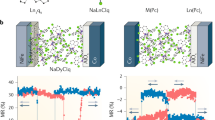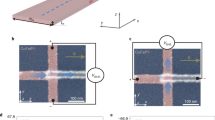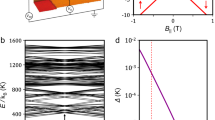Abstract
Spin qubits offer one of the most promising routes to the implementation of quantum computers. Very recent results in semiconductor quantum dots show that electrically-controlled gating schemes are particularly well-suited for the realization of a universal set of quantum logical gates. Scalability to a larger number of qubits, however, remains an issue for such semiconductor quantum dots. In contrast, a chemical bottom-up approach allows one to produce identical units in which localized spins represent the qubits. Molecular magnetism has produced a wide range of systems with properties that can be tailored, but so far, there have been no molecules in which the spin state can be controlled by an electrical gate. Here we propose to use the polyoxometalate [PMo12O40(VO)2]q−, where two localized spins with S = 1/2 can be coupled through the electrons of the central core. Through electrical manipulation of the molecular redox potential, the charge of the core can be changed. With this setup, two-qubit gates and qubit readout can be implemented.
This is a preview of subscription content, access via your institution
Access options
Subscribe to this journal
Receive 12 print issues and online access
$259.00 per year
only $21.58 per issue
Buy this article
- Purchase on Springer Link
- Instant access to full article PDF
Prices may be subject to local taxes which are calculated during checkout




Similar content being viewed by others
References
van der Wiel, W. G. et al. Electron transport through double quantum dots. Rev. Mod. Phys. 75, 1 (2003).
Burkard, G., Loss, D. & DiVincenzo, D. P. Coupled quantum dots as quantum gates. Phys. Rev. B 59, 2070–2078 (1999).
Barenco, A. et al. Elementary gates for quantum computation. Phys. Rev. A 52, 3457–3467 (1995).
Loss, D. & DiVincenzo, D. P. Quantum computation with quantum dots. Phys. Rev. A 57, 120–126 (1998).
Nielsen, M. A. & Chuang, I. L. Quantum Computation and Quantum Information (Cambridge Univ. Press, New York, 2000).
Petta, J. R. et al. Coherent manipulation of coupled electron spins in semiconductor quantum dots. Science 309, 2180–2184 (2005).
Koppens, F. H. L. et al. Driven coherent oscillations of a single electron spin in a quantum dot. Nature 442, 766–771 (2006).
Hirjibehedin, C. F., Lutz, C. P. & Heinrich, A. J. Spin coupling in engineered atomic structures. Science 312, 1021–1024 (2006).
Heersche, H. B. et al. Electron transport through single Mn12 molecular magnets. Phys. Rev. Lett. 96, 206801 (2006).
Jo, M.-H. et al. Signatures of molecular magnetism in single-molecule transport spectroscopy. Nano Lett. 6, 2014–2020 (2006).
Kahn, O. Molecular Magnetism (VCH, New York, 1993).
Gatteschi, D., Sessoli, R. & Villain, J. Molecular Nanomagnets (Oxford Univ. Press, Oxford, 2006).
Wernsdorfer, W. & Sessoli, R. Quantum phase interference and parity effects in magnetic molecular clusters. Science 284, 133 (1999).
Coronado, E., Galán-Mascarós, J. R., Gómez-García, C. J. & Laukhin, V. Coexistence of ferromagnetism and metallic conductivity in a molecule-based layered compound. Nature 408, 447–449 (2000).
Real, J. A., Gaspar, A. B., Niel, V. & Muñoz, M. C. Communication between iron(ii) building blocks in cooperative spin transition phenomena. Coord. Chem. Rev. 236, 121–141 (2003).
Stepanow, S. et al. Steering molecular organization and host–guest interactions using two-dimensional nanoporous coordination systems. Nature Mater. 3, 229–233 (2004).
Hill, C. L. Special thematic issue on polyoxometalates, Chem. Rev. 98, 1–390 (1998).
Ardavan, A. et al. Will spin-relaxation times in molecular magnets permit quantum information processing? Phys. Rev. Lett. 98, 057201 (2007).
Leuenberger, M. N. & Loss, D. Quantum computing in molecular magnets. Nature 410, 789 (2001).
Troiani, F., Affronte, M., Carretta, S., Santini, P. & Amoretti, G. Proposal for quantum gates in permanently coupled antiferromagnetic spin rings without need of local fields. Phys. Rev. Lett. 94, 190501 (2005).
Chen, Q. & Hill, C. L. A bivanadyl capped, highly reduced keggin polyanion, [PMoV6MoVI6 O40(VIVO)2]5 −. Inorg. Chem. 35, 2403–2405 (1996).
Keggin, J. F. Structure of the molecule of 12-phosphotungstic acid. Nature 131, 908 (1933).
Datta, S. et al. Current–voltage characteristics of self-assembled monolayers by scanning tunneling microscopy. Phys. Rev. Lett. 79, 2530 (1997).
Park, H., Lim, A. K. L., Alivisatos, A. P., Park, J. & McEuen, P. L. Fabrication of metallic electrodes with nanometer separation by electromigration. Appl. Phys. Lett. 75, 301–303 (1999).
Kubatkin, S. et al. Single-electron transistor of a single organic molecule with access to several redox states. Nature 425, 698–701 (2003).
Wolf, E. L. Principles of Electron Tunneling Spectroscopy (Oxford Univ. Press, New York, 1989).
Lehmann, J. & Loss, D. Cotunneling current through quantum dots with phonon-assisted spin-flip processes. Phys. Rev. B 73, 045328 (2006).
Shi, Z., Peng, J., Gómez-García, C. J., Benmansour, S. & Gu, X. Influence of metal ions on the structures of keggin polyoxometalate-based solids: Hydrothermal syntheses, crystal structures and magnetic properties. J. Solid State Chem. 179, 253–265 (2006).
Bonchio, M., Bortolini, O., Conte, V. & Sartorel, A. Electrospray behavior of lacunary keggin-type polyoxotungstates [XW11O39]p − (X= Si, P): Mass spectrometric evidence for a concentration-dependent incorporation of an MOn + (M = WVI, MoVI, VV) unit into the polyoxometalate vacancy. Eur. J. Inorg. Chem. 4, 699–704 (2003).
Mayer, C. R. et al. New organosilyl derivatives of the dawson polyoxometalate [α2P2W17O61(RSi)2O]6 −: Synthesis and mass spectrometric investigation. Chem. Eur. J. 10, 5517–5523 (2004).
Shultz, D. A. & Sandberg, K. A. Semiempirical computational assessment of porphyrins as building blocks for molecule-based magnets: spin–spin coupling in radical-substituted metallo porphyrins. J. Phys. Org. Chem. 12, 10–18 (1999).
Green, J. E. et al. A 160-kilobit molecular electronic memory patterned at 1011 bits per square centimetre. Nature 445, 414–417 (2007).
Engel, H.-A. & Loss, D. Detection of single spin decoherence in a quantum dot via charge currents. Phys. Rev. Lett. 86, 4648–4651 (2001).
Kohler, S., Lehmann, J. & Hänggi, P. Driven transport on the nanoscale. Phys. Rep. 406, 379–443 (2005).
Poyatos, J. F., Cirac, J. I. & Zoller, P. Complete characterization of a quantum process: The two-bit quantum gate. Phys. Rev. Lett. 78, 390–393 (1997).
Acknowledgements
We thank W.A. Coish for discussions and Murad AlDamen for his collaboration with the ab initio calculations. Financial support by the EU Research Training Network QuEMolNa (MRTN-CT-2003-5044880), the EU Network of Excellence MAGMANet (NMP3-CT-2005-515767), the National Center of Competence in Research Nanoscience, the Swiss NSF, the Spanish Ministerio de Educación y Ciencia (MAT2004-3849) and the Generalitat Valenciana is acknowledged.
Author information
Authors and Affiliations
Corresponding author
Ethics declarations
Competing interests
The authors declare no competing financial interests.
Supplementary information
Supplementary Information
Supplementary discussion, figures S1 and S2, supplementary references (PDF 1162 kb)
Rights and permissions
About this article
Cite this article
Lehmann, J., Gaita-Arin̄o, A., Coronado, E. et al. Spin qubits with electrically gated polyoxometalate molecules. Nature Nanotech 2, 312–317 (2007). https://doi.org/10.1038/nnano.2007.110
Received:
Accepted:
Published:
Issue Date:
DOI: https://doi.org/10.1038/nnano.2007.110
This article is cited by
-
Coupled reaction equilibria enable the light-driven formation of metal-functionalized molecular vanadium oxides
Nature Communications (2023)
-
Triplet-mediated spin entanglement between organic radicals: integrating first principles and open-quantum-system simulations
NPG Asia Materials (2023)
-
Electrical two-qubit gates within a pair of clock-qubit magnetic molecules
npj Quantum Information (2022)
-
EPR Spectroscopy of Impurity Ytterbium Ions in Synthetic Forsterite Single Crystals
Applied Magnetic Resonance (2022)
-
Exploiting chemistry and molecular systems for quantum information science
Nature Reviews Chemistry (2020)



